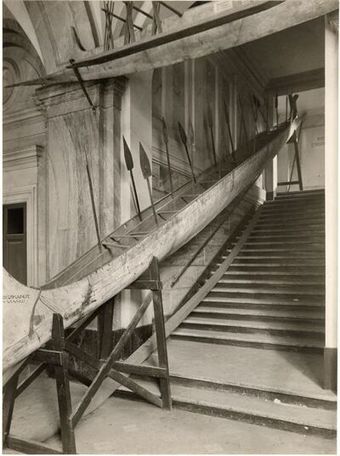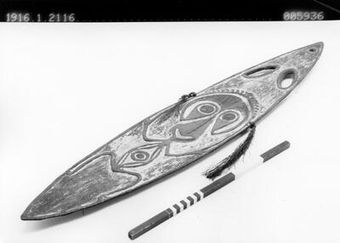Connect with Horniman Museum and Gardens
Contact this content partner to get more information about this item.
canoe board
- Description:
- Engraved Canoe Splashboard, Dogina Lagim, Trobriand Islands, Massim Province, Papua New Guinea. The Trobriands are famous in anthropology for the Kula Ring – a remarkable circular system of ceremonial exchanges between neighbouring islands that was first brought to the world’s attention by the Bronislaw Malinowski in his famous work Argonauts of the Western pacific. During Kula, masawa outrigger sailing canoes are piloted from one island to the next, and personally named, valuable shell armlets (mwari) are ceremonially exchanged for similarly named and valuable necklaces (vaiguwa). Men maintain and increase the prestige of themselves and their island by acquiring a more prestigious kula object in exchange for giving away a lesser one, and the whole business of Kula involves elaborate ritual practices and the making of magical artworks to bring this about. The carving and painting of splashboards (lagim) and prowboards (tabuya) for the masawa canoes is a central part of this magic, and the motifs combine a number of scroll elements and animal forms into a composition which is intended to dazzle with its brilliance and lead the exchange partners to make an exchange not to their own advantage. Wood, pigment. Late 19th century. Formerly in the private collection of Commodore James Elphinstone Erskine, the Scottish naval officer who proclaimed a British Protectorate over southeastern New Guinea in 1884; as he returned to Britain in 1885, it is likely that this object was acquired by him during that time. Purchased by the Horniman Museum alongside other Erskine items at Stevens Auction Rooms, 1914. Canoe prow board from a kula trading canoe, incised with designs representing supernatural animals that magically encourage the trading partners to give up more valuable objects than they are acquiring.
- Format:
- image
- Collections:
- Horniman Museum and Gardens
- Content partner:
- Horniman Museum and Gardens
- Availability:
- Not specified
-
Copyright status: All rights reservedFind out more about what you are able to do with this itemThis item is all rights reserved, with means you'll have to get permission from Horniman Museum and Gardens before using it. For more information, please see our use and reuse page.More informationHorniman Museum and Gardens has this to say about the rights status of this item:
http://rightsstatements.org/vocab/InC/1.0/
What can I do with this item?Non-infringing useNZ copyright law does not prevent every use of a copyright work, and this item may be hosted by an international institute or organisation. You should consider what you can and cannot do with a copyright work.No sharingYou may not copy and/or share this item with others without further permission. This includes posting it on your blog, using it in a presentation, or any other public use.No modifyingYou are not allowed to adapt or remix this item into any other works.No commercial useYou may not use this item commercially.
Welcome and warm Pasifik greetings
The information on this site has been gathered from our content partners.
The names, terms, and labels that we present on the site may contain images or voices of deceased persons and may also reflect the bias, norms, and perspective of the period of time in which they were created. We accept that these may not be appropriate today.
If you have any concerns or questions about an item, please contact us.


